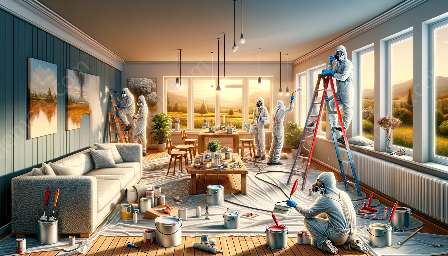Painting can be a fun and fulfilling task, helping to transform the interior and exterior of our homes. However, it's essential to prioritize safety while working with paint to protect ourselves and our living spaces. This article will provide valuable guidance on safety precautions while painting, with a focus on keeping both the painter and the surrounding environment safe and healthy.
Understanding the Risks
Before we delve into the safety precautions, it's important to understand the potential risks associated with painting. Paints, especially those containing volatile organic compounds (VOCs), can release harmful fumes into the air. Physical hazards such as slips, trips, and falls can also occur when painting, along with potential skin and eye irritation from contact with paint and paint chemicals.
Pre-Painting Safety Preparations
- Ventilation: Ensure that the painting area is well-ventilated. Open windows and doors to allow for proper airflow and consider using fans to circulate air.
- Protective Gear: Wear protective clothing, gloves, goggles, and a mask to shield yourself from paint fumes and avoid skin and eye contact with paint. Use a respirator rated for paint fumes if working in an enclosed space.
- Cleanup: Clear the painting area of any clutter or obstacles that could lead to accidents or spills. Keep the floor dry and clean to prevent slipping hazards.
- Prep Surfaces: Ensure that the painting surfaces are clean and dry to facilitate proper paint adhesion and to minimize the risk of accidents.
During the Painting Process
When actually painting, it is crucial to maintain safety measures to prevent accidents and minimize exposure to hazardous materials:
- Adequate Lighting: Ensure that the painting area is well-lit to help prevent missteps and accidents.
- Proper Use of Ladders and Scaffolding: Use stable and secure ladders or scaffolding when working on elevated surfaces. Ensure that they are set up on a level and stable surface to prevent falls.
- Minimize Contact with Paint: Be mindful of skin and eye contact with paint. Use drop cloths to protect surrounding surfaces and clean up spills promptly to prevent slips and falls.
- Maintain Ventilation: Continue to ensure proper ventilation throughout the painting process to minimize inhalation of fumes.
Clean-Up and Disposal
After completing the painting project, it's essential to observe safety precautions for clean-up and disposal:
- Safely remove and dispose of any used paint cans, brushes, and other painting materials according to your local regulations and guidelines.
- Clean any spills or splatters promptly using appropriate cleaning materials and techniques to avoid slips and falls.
- Thoroughly clean all painting equipment and tools, and store them in a safe and organized manner to prevent accidents and prolong their use.
Conclusion
In conclusion, prioritizing safety while painting is crucial for both personal well-being and the upkeep of our living spaces. By understanding the potential risks associated with painting and adhering to essential safety precautions, we can enjoy the process of transforming our homes with peace of mind. Remember, a beautiful living space is only truly satisfying when it's achieved through safe and responsible practices.



















